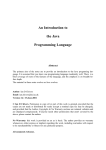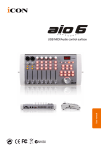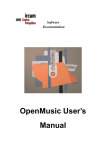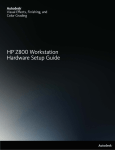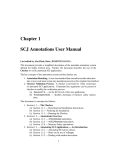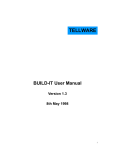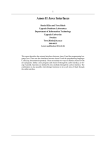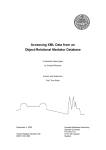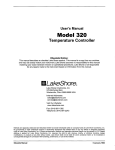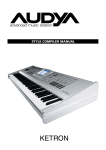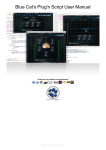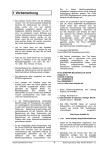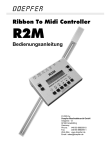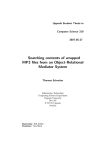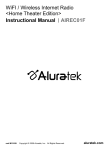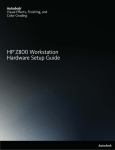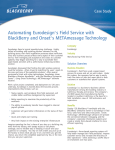Download A Wrapper for MIDI files from an Object
Transcript
A Wrapper for MIDI files from an Object-Relational
Mediator System
Semester thesis in informatics for the University of Zürich
Written by
Martin Jost
Zürich, Switzerland
Studentnumber 97-709-968
Made at the
Department of Information Science
at Uppsala University, Sweden
Prof. Tore Risch
1 INTRODUCTION ........................................................................................... 4
2 WHAT IS MIDI? ............................................................................................. 5
2.1 Streaming Data in the MIDI Wire Protocol .....................................................5
2.2 Sequenced Data in Standard MIDI Files ...........................................................6
2.3 The basic structure of MIDI ..................................................................................6
2.3.1 Channel-Events..........................................................................................................7
2.3.2 Meta-Events ............................................................................................................10
2.3.3 Sysex-Events ...........................................................................................................10
3 THE JAVA SOUND API........................................................................... 12
3.1 The Java Sound API’s Representation of MIDI Data .................................12
3.1.1 MIDI Messages .......................................................................................................12
3.1.2 MIDI Events ............................................................................................................13
3.1.3 Sequences and Tracks ..............................................................................................13
3.2 Use of the Java Sound API...................................................................................13
4 DATABASE SCHEMA ............................................................................. 16
5 EXAMPLES.................................................................................................... 20
6 SUMMARY ..................................................................................................... 23
7 REFERENCES ............................................................................................. 24
8 APPENDIX.............................................ERROR! BOOKMARK NOT DEFINED.
A Code listing and comments...........................................Error! Bookmark not defined.
B Database creation scripts ..............................................Error! Bookmark not defined.
C Installing instructions ....................................................Error! Bookmark not defined.
2
Table 1: Summary of MIDI Status Bytes ................................................................................8
Table 2: Summary of most common MIDI Status & Data Bytes .............................................9
Table 3: Summary of MIDI Note Numbers for Different Octaves...........................................9
Table 4: Selected meta event types .......................................................................................10
Table 5: Syntactic variants of sysex events ...........................................................................11
Fig.1: The object oriented database scheme for Midi ............................................................19
3
1 Introduction
In the 80ties the relational database models prevailed in the practice. In many fields of
application of the commercial and administrative world they found and find still their use.
And this is totally entitled, because for these areas, the data model is optimally developed.
In the beginning of the 90ties the database world expanded into the area of multimedia
applications and one determined quickly that the until now well known relational database
models were not able to suffice the new demands to describe more complex objects. The User
of so-called non-standard applications (CAD/CAM etc.) demanded a database model with
which they also could store and manage the objects of their world.
Due to this fact, the search for a new database model started. This time the goal was the object
oriented database model.
The goal of this project is to extend the Object-Oriented (OO) multi-database system Amos II
with a wrapper implemented in Java, which can access MIDI files trough the net by giving the
wrapper an URL of a midi file and store it in the database. To understand what is AMOS II, I
will give a brief description about it.
AMOS II is a descendant of AMOS, which has its roots in a main memory version of Hewlett
Packard’s DBMS IRIS. The entire database is stored in main memory and is saved on disk
only through explicit commands. AMOS II can be used as a single user database, a multi-user
server, or as a collection of interacting AMOS II multi-database servers. AMOS II has a
functional data model with a relationally complete object-oriented query language,
AMOSQL. The AMOS II data manager is extensible so that new data types and operators can
be added to AMOSQL, implemented in some external programming language (Java, C, or
Lisp).
AMOS II is implemented in C and runs under Windows 95/98 and Windows NT 4.0. For
more information about AMOS II, see [1].
To achieve the goal, the project was divided in the following 6 issues:
1. I had to acquire consolidated knowledge about the MIDI standard and its protocols. I
will expatiate this issue in chapter 1.
2. The second task was to look after and select a development environment especially for
Java classes, which can access MIDI files. To my advantage Sun’s JDK 1.3 natively
supports MIDI and sampled audio access. The Java Sound API will be discussed in
Chapter 3.
3. One of the most important tasks was the investigation of an object oriented database
scheme for the MIDI structure according to the Java Sound API.
4. In the next phase I designed primitive foreign functions which take the name of a
MIDI file as a parameter, accessing them trough the web and then emitting a stream of
AMOS II objects and attributes, according to the schema, to the mediator.
5. In chapter 5 I will show that useful queries can be specified over the schema and
therefore the usefulness of a foreign function for MIDI.
6. Last but not least, the whole application had to be packaged and installed in a running
AMOS II environment at the University of Uppsala.
4
2 What is midi?
The Musical Instrument Digital Interface (MIDI) standard defines a communication protocol
for electronic music devices, such as electronic keyboard instruments and personal computers.
MIDI data can be transmitted over special cables during a live performance, and can also be
stored in a standard type of file for later playback or editing.
MIDI is both a hardware specification and a software specification. To understand MIDI’s
design, it helps to understand its history. MIDI was originally designed for passing musical
events, such as key depressions, between electronic keyboard instruments such as
synthesizers. Hardware devices known as sequencers stored sequences of notes. Those
sequences could control a synthesizer, allowing musical performances to be recorded and
subsequently played back. Later, hardware interfaces were developed that connected MIDI
instruments to a computer’s serial port, allowing sequencers to be implemented in software.
More recently, computer sound cards have incorporated hardware for MIDI I/O and for
synthesizing musical sound. Today, many users of MIDI deal only with sound cards, never
connecting to external MIDI devices. CPUs have become fast enough that synthesizers, too,
can be implemented in software. A sound card is needed only for audio I/O and, in some
applications, for communicating with external MIDI devices.
The brief hardware portion of the MIDI specification prescribes the pin outs for MIDI cables
and the jacks into which these cables are plugged. This portion need not concern us. Because
devices that originally required hardware, such as sequencers and synthesizers, are now
capable of being implemented in software, perhaps the only reason for most programmers to
know anything about MIDI hardware devices is simply to understand the metaphors in MIDI.
However, external MIDI hardware devices are still essential for some important music
applications.
The software portion of the MIDI specification is extensive. This portion concerns the
structure of MIDI data and how devices such as synthesizers should respond to that data. It is
important to understand that MIDI data can be streamed or sequenced. This duality reflects
two different parts of the Complete MIDI 1.0 Detailed Specification:
• MIDI 1.0
• Standard MIDI Files
I will explain what streaming and sequencing means by examining the purpose of each of
these two parts of the MIDI specification.
2.1 Streaming Data in the MIDI Wire Protocol
The first of these two parts of MIDI specification describes what is known informally as
“MIDI wire protocol”. MIDI wire protocol, which is the original MIDI protocol, is based on
the assumption that the MIDI data is being sent over a MIDI cable (the “wire”). The cable
transmits digital data from one MIDI device to another. Each of the MIDI devices might be a
musical instrument or a similar device, or it might be a general-purpose computer equipped
with a MIDI-capable sound card or a MIDI-to-serial-port interface.
MIDI data, as defined by MIDI wire protocol, is organized into messages. The different kinds
of message are distinguished by the first byte in the message, known as the status byte. (Status
bytes are the only bytes that have the highest-order bit set to 1). The bytes that follow the
5
status byte in a message are known as data bytes. Certain MIDI messages, known as channel
messages, have a status byte that contains four bits to specify the channel number. There are
therefore 16 MIDI channels; devices that receive MIDI messages can be set to respond to
channel messages on all or only one of these virtual channels. Often each MIDI channel
(which shouldn’t be confused with a channel of audio) is used to send the notes for a different
instrument. As an example, two common channel messages are Note On and Note Off, which
start a note sounding and then stop it, respectively. These two messages each take two data
bytes: the first specifies the note’s pitch and the second its “velocity” (how fast the key is
depressed or released, assuming a keyboard instrument is playing the note).
MIDI wire protocol defines a streaming model for MIDI data. A central feature of this
protocol is that the bytes of MIDI data are delivered in real time – in other words, they are
streamed. The data itself contains no timing information; each event is processed as it’s
received, and it’s assumed that it arrives at the correct time. That model is fine if the notes are
being generated by a live musician, but it’s insufficient if you want to store the notes for later
playback, or if you want to compose them out of real time. This limitation is understandable
when you realize that MIDI was originally designed for musical performance, as a way for a
keyboard musician to control more than one synthesizer, back in the days before many
musicians used computers. (The first version of the specification was released in 1984.)
2.2 Sequenced Data in Standard MIDI Files
The Standard MIDI Files part of the MIDI specification addresses the timing limitation in
MIDI wire protocol. A standard MIDI file is a digital sequence that contains MIDI events. An
event is simply a MIDI message, as defined in the MIDI wire protocol, but with an additional
piece of information that specifies the event’s timing. (There are also some events that don’t
correspond to MIDI wire protocol messages.) The additional timing information is a series of
bytes that indicates when to perform the operation described by the message. In other words, a
standard MIDI file specifies not just which notes to play, but exactly when to play each of
them. It’s a bit like a musical score.
The information in a standard MIDI file is referred to as a sequence. A standard MIDI file
contains one or more tracks. Each track typically contains the notes that a single instrument
would play if live musicians performed the music. A sequencer is a software or hardware
device that can read a sequence and deliver the MIDI message contained in it at the right time.
A sequencer is a bit like an orchestra conductor, it has the information for all the notes,
including their timings, and it tells some other entity when to perform the notes.
2.3 The basic structure of MIDI
Finally I want to give a short set over the basic structure of MIDI on a rather low level of the
MIDI specification.
A standard MIDI file consists of a header and one or more tracks.
<Standard-MIDI-File> := <Header> <Track> [<Track>]...
6
The first 4 bytes of the header are the identifier of a MIDI file, followed by some information
bytes.
<Header> := 4D 54 68 64 00 00 00 06 00 xx yy yy zz zz
xx := {00 | 01}
Type of the MIDI-File:
Type 0: File has only one track,
Type 1: File has several tracks.
yy yy
zz zz
Number of Tracks
Timestamp: Number of Time elements per ¼ note;
should be divided trough 24.
Common values are:
00 78 (120), 00 F0 (240), 01 E0 (480), 03 C0 (960).
A track consists of a header and one or more events separated by a time difference.
<Track> := <Track-Header><Time-difference><Event>[<Timedifference><Event>]…
The track header has following information bytes:
<Track-Header> := 4D 54 72 6B xx xx xx xx
Whereby xx xx xx xx is the length of the track in bytes without the track header itself.
The time difference between the events is measured in timestamps. The first time difference
counts from the beginning of the piece of music to the first event of the track and is coded in
variable length.
An event can be either a channel event, a meta event or a sysex event and is the elementary
command to the playback device.
<Event> := {<Channel-Event> | <Meta-Event> | <Sysex-Event>}
Let us have now a closer look on those elementary commands, since they hold the most
important information in a MIDI file and thereby they are also necessary for the modelling of
the object oriented database scheme.
2.3.1 Channel-Events
A channel event is a command to a certain MIDI channel of the playback device. The general
syntax is as follows:
<Channel-Event> := [<Status-Byte>] <Data-Byte> [<Data-Byte>]
The status byte contains the type of the event and the channel number, on which the playback
device executes the event.
<Status-Byte> := <Event-Type> <Channel-Number>
7
The first (leading) nibble of the status byte is the event type; it specifies the type of the
command. Common values are 0x90 (Note On) and 0x80 (Note Off), see table 1 for details.
<Event-Type> := {8 | 9 | A | B | C | D | E}
The second nibble of the status byte declares the number of the MIDI channel which to
perform the command on. The numbering starts with 0.
<Channel-Number> := {0 | … | F}
The data byte contains the parameter of the command. See Table 2 for explicit values and
signification.
<Data-Byte> := {00 | … | 7F}
Setting the status byte only in the first event and omitting it in the following events can
shorten a chain of channel events with the same status byte. This use is practically always
made. The coding is explicit, since data bytes are smaller than 80 bytes and status bytes
greater or equal 80 bytes.
$#% '&#" "
56 "
"#
74
4
()*
()(
5 !#" "
5 !#"4!# 56 "
"9'!
2) C 0 5 !
9
E!
.3FG242
E!
.3F"
7
. 6 =#"9
7!# 1'7
4
.
()*=
()=
(
()*%?
()*>
()8
(
()I
(
()(
()$(
7
.!4 56 "
&!#"J7!
!"'7!# ".
&!#"&# %
&A
4
&A!
&1.#B) &1.#BM#
C 3 " 5 !N
C"M
O#
() 5 (
( )*%+
()*%L
()*$
()* 5
()*%(
()**
()*8
()*%@
!#"
+
,&.0/1.324!##$#% '&#" "
5 !#30"93 :2.! 56 "
"74
4';.$24.#4.!# 6
<
+
(8
0
+
,#>
&.0/1.324!# 5 !#" "'0
5 !#30
"93
:2.! 5 !#"4! 56 "
0
>?
@
+-?
&.0/1.324!#
"9'!
2&1AB) 0
+->
&.0/1.324!#C 3D04.#*40
5 !#30
"93
:2.!HE!
.3FG242H
>+8
5 !#30
"93
:2.!HE!
.3F"'0
>%-
5 !#30
"93
:2.!H7
. 6 =#"9J0
+
+5 !#30
"93
:2.!H7!# 1 6 !#" :K
1'74
4
>@
(
;.$#2..4A! 6< 0
5 !#30
"93
:2.!H7
4!
4
56 "0
>%I+
+-+
&.0/1.324!#&!#"J7!
!"'7!# ".H0
+-L
&.0/1.324!#G&!#"&
# %H0
+
,
(
&.0/1.324!#&A
4G0
+
,
+
&.0/1.324!#&A!'0
+-(
&.0/1.324!#&1.#B) '0
+
,
,
&.0/1.324!#&1.#BM#
H0
+-
8
&.0/1.324!##C 3 " 5 !N00
+-@
&.0/1.324!##C"M
O#
H0
Table 1: Summary of MIDI Status Bytes
8
C13!2%!30"9
>#.'=1.
+.'=1.
# !
41:24!# 6 E!
.3F"
#"# '(
(' ()I
(
C#!#"
. 6 24!#9. 9
"24!#A0 !#":
/!# 6 : ./
'L #"'#4% !#" 6 3.!#"
. 6 0 "AA4
.
93:%#4. "
4 !#"' "A
0#"
C#!#"
. 6
()8
(
C#!#"
. 6
!"
()$(
# !
41:24!# 6 E!
.3FG2.2
#"*4!B0!
9 %
0 "!#4
9
# $ # "%& ()=
(
CA":!#"0!
2'G"!
.
C 6 "!. 0
1
9J
" :
./
3!#30"9
E!
.3FG242 6 #"
C 6 #43
.:!
!
/ >#E /
/ :!
2
6 '&.
=1A
()I
(
(
(
# "%$* ,, ()(
C#!#"
. 6 !" 6 6 6 3!#30"9
%
2 6 4 '"!.3A"9
!#"
E3/#!
2 6 4
.!# C 6 #4
43!049
2A "
9J4 .!#40 "
6 2A % !" (
( ' 56 !# %3!
2 6 3!"9/"
N
(
? '(#!# 0
()
$ ' &A4
!! !#"
E3/#!
2 6 4!
#4
C 6 % "
0#"!2H "A0".0 9.#A3 "
9J ": 6 2 % !#" " 6 "%
9'A
"9
49
3 6 4
# .!#!#"9J/
"N24!#
!#
"93A !#"
G!
9# 2A 93 ! 41
* - !"(./
()(
7 . 6 /#"9
C 6 : ! 41:!
2'"!. 6 "
9
* &%+
() 5 (
# "%&
56 !# %3!
2 6 0 !9 "A0"!#9A
56 " "'!
2 6 :# ! .1
!
2 A
"" "J"!
.
0 "
6 3 6 "
"#
56 " "' 6 A
"" "
"!
.
"
!9 2A 9:# !
41
5 !#".! 93A / E!"
E!"
Table 2: Summary of most common MIDI Status & Data Bytes
FG%.
5
0
(
>
+
L
,
@
8
?
I
>%(
5
(
%> +
+L @
-8
@(
?+
8I
@
>(8
>+(
0
>
> L
+
,
L
?
-
I
@#>
?
L
8,
I?
>(I
>+#>
0
+
%> +
@
L8
, (
@ +
?8 @
I
8
>
>(
>+
+
L
> ,
+
?
LI
#, >
@
L
?
,
8?
I
I
>>
>
>%+
L
*
%> @
+8
- (
,+
@?@
88
>((
>
>%+
>+-
*0
,
%> ?
+I
-#>
,L
@,
??
8I
>(#>
>
>L
>+
,
@
%> 8
L
(
-+
,@
@
?8
I(
>(
+
>
>%>+
@
1
10
?
%> I
L#>
-L
,
,
@
?
?I
I>
>%(
L
>>,
>%+
?
8
+
(
L +
-
,
@
@8
8(
I+
>%(>>@
$
$0
I
+>
LL
-
,
,?
@I
#8 >
I
L
>(,
>
>%?
>(
+
+
L-@
,8
?
(
8+
I
>(
@
>
>%8
=
>
>
+
L
L
,
-?
,I
?#>
8L
I,
>(
?
>
>%I
Table 3: Summary of MIDI Note Numbers for Different Octaves
9
2.3.2 Meta-Events
Meta events are not transmitted to the playback device. They control the playback tempo and
provide additional information for better reading and understanding of a MIDI file. The
general syntax is as follows:
<Meta-Event> := FF <Event-Type> <Length> [<Content>]
The type of the meta event is determined by the <Event-Type>. The <Length> parameter
contains the following content in bytes. There is no content, if the length equals 0. Based on
that syntax, meta events can be delimited in a data stream. A MIDI program doesn’t have to
know therefore the content of all meta events.
Selected meta events are represented in order of their meaning (the most important first).
#" 6
(
(
5 #! ".#"
E!#"
C##3!
#, >
C 0'& #"
4 , 8
K13&# "4 , I
(
L
(
( +
))0))0)%)
))01
1 0(8
))011
C.N0E0
(
L
$"%1
$"1
"A
0#"
(-
$"%1
$"1
C#)
&!#"3C#)
(#>
(
,
$"%1
$"%1
$"1
$"1
#.92A "9
?*
$"%1
$"1
% #"4C1
C.N0"9
+*
A !"
."93 6 3#"93!
2 6 4N
C 6 3#"H 4#4#".9J " 9 "' 6 3 039# 2424#4#"%/1 (('**0+*
(
( C3! "'3 4!
%!"9
:#O4.#"!
.
=
G "'H N0#O
..H"!
.
)
) ( N1 6 G)):4!
)
) ( N1 6 ))'= )) ' ( 5 0 !# 3 "! 11 ' ( 0 !# 1%1 ' > 3 "!
E
03!
2 6 34N 1:9
A !#":!
2 6 "A0#"
C 6 "
03!
2 6 32A .4N0 0 ".#A4
.
9
!
24.#":!"' $ O"%.9
!"!
H "9 %.39
A !#":!
2 6 "A0#"
$"%1:%!#30"
C)G0!9
3.!3 "
0 6 & 6 ! 9'."939 .% 1:2..
6 4# "HE!.3F0"0#"G ": 6 '0# !
9
1:4N !
"!
H/%!#0 "9# .
9J/%1: O##"%#4
$"%1
Table 4: Selected meta event types
2.3.3 Sysex-Events
These are system exclusive commands that are used by the MIDI standard. In a standard
MIDI file, sysex events are represented as follows:
<Sysex-Event> := {F0 <Length> <Content> | F7 <Length> <Content>}
The <Length> parameter indicates the length of the following content in bytes.
Long command sequences are supposed to be transmitted in little portions with certain
intervals. Therefore there are several syntactic variants, that all can be led back to both named
variants:
10
M#4#". !#"' ": 6 :2 *( #"
6 5 !#30"9
*(
* ?
* ?
#"
6
#"
6
#"
6
5 !#30"9
5 !#30"9
5 !#30"9
*?
*?
&# "
2A %"%
5 #! 3 .31):"
C 6 32A " #"
*?
0 " 9
9 ": 6 ' " 6
C 6 32A 4H!4 !#"0!
2:#4A9'"
&
O#!2:4.9'"
"9'!
2:#4.
9'#"
C 6 3#"9' "
*?' 0 " 99J "0 6 #"
6
C!34"3 *
( 5 !30"9
*%?
*(
5 !30"9
5 !#30
"9 5 !#30
"9 *?
Table 5: Syntactic variants of sysex events
11
3 The Java Sound API
The Java Sound API is a low-level API for effecting and controlling the input and output of
sound media, including both audio and Musical Instrument Digital Interface (MIDI) data. The
Java Sound API provides explicit control over the capabilities normally required for sound
input and output, in a framework that promotes extensibility and flexibility.
The Java Sound API provides the lowest level of sound support on the Java platform. It
provides application programs with a great amount of control over sound operations, and it is
extensible. For example, the Java Sound API supplies mechanisms for installing, accessing
and manipulating system resources such as audio mixers, MIDI synthesizers, other audio or
MIDI devices, file readers and writers and sound format converters. The Java Sound API does
not include sophisticated sound editors or graphical tools, but it provides capabilities upon
which such programs can be built. It emphasizes low-level control beyond that commonly
expected by the end user.
The Java Sound API includes support for both digital audio and MIDI data. These two major
modules of functionality are provided in separate packages:
• javax.sound.sampled
This package specifies interfaces for capture, mixing and playback of digital
(sampled) audio.
• javax.sound.midi
This package provides interfaces for MIDI synthesis, sequencing and event
transport.
Two other packages permit service providers (as opposed to application developers) to create
custom software components that extend the capabilities of an implementation of the Java
Sound API:
• javax.sound.sampled.spi
• javax.sound.midi.spi
The rest of the chapter I will concentrate on the classes of the javax.sound.midi package,
which are relevant for accessing and manipulating MIDI files.
3.1 The Java Sound API’s Representation of MIDI Data
3.1.1 MIDI Messages
MidiMessage is an abstract class that represents a “raw” MIDI message. A “raw” MIDI
message is usually a message defined by the MIDI wire protocol. It can also be one of the
events defined by the Standard MIDI Files specification, but without the event’s timing
information. There are three categories of raw MIDI message, represented in the Java Sound
API by these three respective MidiMessage subclasses:
•
•
ShortMessages are the most common messages and have at most two data
bytes following the status byte. The channel messages, such as Note On and Note
Off, are all short messages, as are some other messages.
SysexMessages contain system-exclusive MIDI messages. They may have
many bytes, and generally contain manufacturer-specific instructions.
12
•
MetaMessages occur in MIDI files, but not in MIDI wire protocol. Meta
messages contain data, such as lyrics or tempo settings, that might be useful to
sequencers but that are usually meaningless for synthesizers.
3.1.2 MIDI Events
As we’ve seen, standard MIDI files contain events that are wrappers for “raw” MIDI
messages along with timing information. An instance of the Java Sound API’s MidiEvent
class represents an event such as might be stored in a standard MIDI file.
The API for MidiEvent includes methods to set and get the event’s timing value. There’s
also a method to retrieve its embedded raw MIDI message, which is an instance of a subclass
of MidiMessage. (The embedded raw MIDI message can be set only when constructing the
MidiEvent.)
3.1.3 Sequences and Tracks
As mentioned earlier, a standard MIDI file stores events that are arranged into tracks. Usually
the file represents one musical composition, and usually each track represents a part such as
might have been played by a single instrumentalist. Each note that the instrumentalist plays is
represented by at least two events: a Note On that starts the note, and a Note Off that ends it.
The track may also contain events that don’t correspond to notes, such as meta events (which
were mentioned above).
The Java Sound API organizes MIDI data in a three-part hierarchy:
•
•
•
Sequence
Track
MidiEvent
A Track is a collection of MidiEvents, and a Sequence is a collection of Tracks.
This hierarchy reflects the files, tracks, and events of the Standard MIDI files specification.
(Note: this is a hierarchy in terms of containment and ownership; it’s not a class hierarchy in
terms of inheritance. Each of these three classes inherits directly from java.lang.Object.)
Sequences can be read from MIDI files, or created from scratch and edited by adding
Tracks to the Sequence (or removing them). Similarly, MidiEvents can be added to or
removed from the tracks in the sequence.
3.2 Use of the Java Sound API
In this chapter I want to show some basic functions of the Java Sound API relating to my
foreign function. It should show how the classes and interfaces of the Java Sound API are
used to stream a MIDI file through the net and accessing its tracks, events, and so on. The
following code fragments are taken of my foreign function and can be read more detailed in
Appendix A.
13
In order to load a MIDI file into a sequencer and finally into AMOS II, we have to deliver an
URL of an existing MIDI file to the foreign function. We take the URL parameter of the
foreign function from Amos toploop to create an URL object:
String s = tpl.getStringElem(0);
try {
url = new URL(s);
} catch (MalformedURLException e) { System.out.println(e);
}
The base module in the Java Sound API’s messaging system is MidiDevice (a Java
language interface). MidiDevice include sequencers (which record, play, load, and edit
sequences of time-stamped MIDI messages), synthesizers (which generate sounds when
triggered by MIDI messages), and MIDI input and output ports, through which data comes
from and goes to external MIDI devices. In our case we need to load a sequencer to access the
MIDI sequence of our URL object. We also try to load a synthesizer, so we can extend in
future our foreign function to play back a MIDI sequence.
Sequencer sequencer;
try {
// Try to load the default Sequencer
sequencer = MidiSystem.getSequencer();
if (sequencer instanceof Synthesizer) {
synthesizer = (Synthesizer)sequencer;
channels = synthesizer.getChannels();
}
} catch (Exception ex) {ex.printStackTrace(); return;}
Now we create a sequence, we invoke MidiSystem’s overloaded method getSequence.
The method is able to get the sequence from an InputStream, a File or an URL like in our
case. The method returns a Sequence object, which we can access now:
Sequence currentSound = MidiSystem.getSequence(url);
// Get some information about the MIDI Sequence
duration = currentSound.getMicrosecondLength() / 1000000.0;
tickLength = currentSound.getTickLength();
resolution = currentSound.getResolution();
divisionType = currentSound.getDivisionType();
To get a reverence to the available Tracks in the Sequence we create a Track object and
invoke Sequence.getTracks:
Track tracks = currentSound.getTracks();
Once the sequence contains tracks, we can access the contents of the tracks by invoking
methods of the Track class. The MidiEvents contained in the Track are stored as a
java.util.Vector in the Track object, and Track provides a set of methods for
accessing, adding and removing the events in the list. The methods add and remove are
fairly self-explanatory, adding or removing a specified MidiEvent from a Track. A get
method is provided, which takes an index into Track’s event list and returns the
14
MidiEvent stored there. In addition, there are size and tick methods, which respectively
return the number of MidiEvents in the track, and the track’s duration, expressed as a total
number of Ticks.
// Loop all MidiEvents in a Track object
for (int i=0; i < tracks.length; i++) {
// Get number of events in a track
events = tracks[i].size();
ticks = tracks[i].ticks();
// Create the MidiEvent object in a Track object
midiEvent = new MidiEvent[events];
// loop the MidiEvent object
for (int j = 0; j < events; j++) {
// obtain the event at the specified index
midiEvent[j] = tracks[i].get(j);
timestamp = midiEvent[j].getTick();
midiMessage = midiEvent[j].getMessage();
// Check if the MidiEvent is a MetaEvent, a
// ChannelEvent or a SysexEvent
if (midiMessage instanceof MetaMessage) {
// Handle the MetaMessage object and create
// the necessary objects and functions in
// AMOS II
//…
}
if (midiMessage instanceof ShortMessage) {
// Handle the ShortMessage object and
// create the necessary objects and
// functions in AMOS II
//…
}
if (midiMessage instanceof SysexMessage) {
// Handle the SysexMessage object and
// create the necessary objects and
// functions in AMOS II
//…
}
}
}
For more detailed information about the classes, interfaces and methods of the Java Sound
API, see the Java 2 Documentation [8].
15
4 Database schema
After we made ourselves now a picture over the Java Sound API, we take a look at the object
oriented data base scheme. One of the most important targets of this project consisted of
developing an object oriented database model in order to be able to store MIDI files in AMOS
II. There were certain basic conditions to consider. First of all the database model is as far as
possible supposed to be object oriented, i.e. to deploy the most important concepts of object
orientation, which AMOS II places to use. Secondly the MIDI specification should be
illustrated as complete and meaningful as possible. And thirdly I could refer to the classes of
the Java Sound API at the development of the database model. In the following I want to
describe briefly my database model as seen in fig. 1. For more detailed information about the
implementation of the database model in AMOS II, see the database creation scripts in
Appendix B.
The database model consists of eight types, whereof three are inherited and three serve as
lookup types for some translations of data. The program takes a loaded MIDI file as a
sequence, in which all tracks and events are contained as we have seen in the previous
chapters. The sequence is decomposed in accordance with the MIDI specification into single
elements and then stored as objects into AMOS II. The type MIDI represents the core MIDI
object, it contains following attributes:
MIDI
URL: String of the URL, which we downloaded the file of
FileName: String of the name of the file
Length: Integer of the size of the file in KB
Duration: Real of the Length of the file in seconds
NumberOfTracks: Integer of the number of existing tracks in the MIDI file
TickLength: Integer of the duration of the MIDI sequence, expressed in MIDI ticks
Resolution: Integer of the timing resolution for the MIDI sequence. That is the number
of ticks per beat or per frame.
DivisionType: Real of the timing division type for this MIDI sequence
As we know already, the MIDI sequence consists of at least one track. These Track objects
are designed under the type Track and are connected over the relation tracks with its MIDI
object. Since there can be several tracks in a MIDI sequence, the relation is implemented as a
set of objects. The type Track has the attributes:
Track
NumberOfEvents: Integer of the number of events in this track
Ticks: Integer of the length of the track expressed in MIDI ticks
The single events in the track are created as objects of type MidiEvent in AMOS II. Each
single MidiEvent is connected with its Track object by the relation midievents. Since there
can be several MidiEvents per Track object, the relation is implemented as a vector of
MidiEvent.
MidiEvent
TimeStamp: Integer obtaining the time stamp for the event in MIDI ticks
Length: Integer of the number of bytes in the MIDI event, including the status byte and
any data bytes
StatusByte: Integer obtaining the status byte for the MIDI event
16
MidiMessage: Byte array containing the MIDI event data. The first byte is the status
byte for the event; subsequent bytes up to the length of the event are data bytes for this
event. In our database scheme the bytes are transformed into integers and stored as a
vector of integers.
The created MidiEvent object can either be a channel event, a meta event or a sysex event
(system exclusive). This is now the point where our database scheme gets object oriented. All
this different events are implemented as a type under the type MidiEvent and therefore are
directly inherited from MidiEvent. Each event (channel, meta and sysex) has the same
attributes, TimeStamp, StatusByte and MidiMessage, which are inherited of the MidiEvent
type. The types ChannelEvent, MetaEvent and SysexEvent are connected through an is-a
relation with the super type. Besides the inherited attributes, each event type has its own
attributes.
ChannelEvent
Channel: Integer obtaining the MIDI channel associated with this event
Command: Integer obtaining the MIDI command associated with this event
Data1: Integer obtaining the first data byte in the message
Data2: Integer obtaining the second data byte in the message
CommandAsString: String representing the command translated to a meaningful String
NoteEvent: derived function to translate the channel event command into a
meaningful string. Information is retrieved from type NoteEvents.
Note: String representing the note of a Note On or a Note Off channel event.
Octave: Integer obtaining the octave of a Note On or a Note Off channel event
MetaEvent
MetaType: Integer obtaining the type of the meta event
MetaDataInt: Obtains a copy of the data for the meta message. The returned array of
bytes does not include the status byte or the message length data. The length of the
data for the meta message is the length of the array. Note that the length of the entire
message includes the status byte and the meta message type byte, and therefore may be
longer than the returned array. In our database scheme the bytes are transformed into
integers and stored as a vector of integers if the data is representing an integer value of
the MIDI file.
MetaDataString: Same as MetaDataInt, except it contains a string. If the data of the
meta event represents a string like lyrics, text or instrument description, the data is
stored in MetaDataString.
MetaTypeAsString: String representing the meta type translated to a meaningful String
SysexEvent
SysexData: Obtains a copy of the data for the system exclusive message. The returned
array of bytes does not include the status byte. The array of bytes is transformed into
integers and stored as a vector of integers in our database scheme.
These are all the types and functions that are needed to model the object oriented database
scheme for the MIDI 1.0 specification. Because a lot of data is stored as simple integers we
extend the database model with three ‘lookup’ types in order to translate the integers into
meaningful data. In fact it is now much easier for the user to search for a specific string
instead of an integer or to understand how the data is represented in a MIDI file. The three
types are ChannelCommands, NoteEvents and MetaCommands. The ChannelCommands type
is connected with the channelEvent type through the derived function commandAsString. It
17
takes the integer of the command of a channel event and translates it into a string. The
NoteEvents type, which is connected through the derived noteEvents function, takes the data
of a Note On or a Note Off event and translate it into the particular Note. Finally, the function
MetaTypeAsString takes the integer of the metaType and translates it through the
MetaCommands type into a string.
ChannelCommands
Command: Integer obtaining the channel commands.
commandString: String representing the translated integer value of a channel
command.
NoteEvents
noteInt: Integer obtaining the integer value of a Note On or Note Off event.
noteString: String representing the note of a Note On or Note Off event as a string.
Octave: Integer obtaining the octave of a Note On or Note Off event.
MetaCommands
MetaTypeInt: Integer obtaining the meta type of a meta event.
MetaTypeString: String representing the meta type translated into a string.
18
ChannelCommands
commandString charstring
command integer
Midi
url charstring
fileName charstring
length integer
duration real
numberOfTracks integer
tickLength integer
resolution integer
divisionType real
NoteEvents
octave integer
noteInt integer
noteString charstring
MetaCommands
metaTypeInt integer
metaTypeString charstring
tracks >
Legend
Entitiy_name
attribute type
Track
numberOfEvents integer
ticks integer
Entities with attributes and their data types
Inheritance (is-a)
relationship >
Relationship with logical direction
Single Object
midievents *>
Set of objects
Vector of objects
MidiEvent
timeStamp integer
length integer
statusByte integer
midiMessage vector of integer
ChannelEvent
channel integer
command integer
data1 integer
data2 integer
commandAsString charstring
noteEvent noteEvents
note charstring
octave integer
MetaEvent
metaType integer
metaData vector of integer
metaTypeAsString charstring
SysexEvent
SysexData vector of integer
Fig.1: The object oriented database scheme for Midi
19
5 Examples
Well, let us see now what are the benefits of this MIDI wrapper for the object-oriented
database AMOS II. In this chapter I want to show some reasonable queries to approximate the
usefulness of this wrapper. We will load some MIDI files in our AMOS II database through
the web and make some queries to retrieve selected information.
First of all we need to set up the environment properly and create the database. Refer to
Appendix C to see the installing instructions.
Once the environment is running, we load some MIDI files into AMOS II:
JavaAMOS 1> loadMidi("http://files.midifarm.com/midifiles/
general_midi/sinatra_frank/myway4.mid");
JavaAMOS 2> loadMidi("http://files.midifarm.com/midifiles/
general_midi/roxette/roxette-sleepinginmycar.mid");
After we loaded as many MIDI files as we want into AMOS II we save the database by the
command:
save
‘midi.dmp’;
Now we can make some queries with AMOS’ II query language AMOSQL. Similarly to
SQL, AMOSQL is a combination of DDL (Data Definition Language) and a DML (Data
Manipulation Language). The query part of the language is similar to SQL.
The following command answers the question ‘Which song last longer than 2 minutes and has
two or more Tracks’.
JavaAMOS 1> select distinct m
from midi m
where duration(m) > 120.00 and tracks(m) >= 2;
Or we can simply search for a MIDI object of a certain interpret:
JavaAMOS 2> select m
from midi m
where like(filename(m),”*sinatra*”);
We can also define functions to retrieve or manipulate data in AMOS II. A function defined in
terms of other functions is called a derived function. Especially if we often need to look for
specific information in the database, we define derived functions. There are already some
derived functions defined in our database scheme. For example to find out which track or
which midi object a midi event belongs to, we have defined the following derived functions in
the database scheme:
create function track(midievent e)-> track t as
select t
from integer i
where
20
midievents(t)[i] = e;
create function midi(midievent m)-> midi as
select midi(track(m));
Now we can use these derived functions to get for example all MIDI objects that play a guitar
as instrument:
JavaAMOS 3> select distinct midi(m)
from metaevent m
where like(metaDataString(m), “*guitar*”);
To answer the question ‘Which songs are written in C-major?’ we have to perform several
commands. As you may remember, key signature data is stored as a meta event in our
database scheme. The key signature has the meta type value 89 that is translated into the
string “Key Signature”. The data itself is represented as a vector of two integers. To find now
a song written in c-major, we have to look for a vector with two zeros as integers. For more
details see table 4.
First we create a derived function to look for the specific vector of integers that represents a cmajor song:
JavaAMOS 4> create function major(metaevent m)->metaevent as
select m from metaevent m
where metadataint(m)[0]=0
and metadataint(m)[1]=0
and metatypeasstring(m) = “Key Signature”;
The following command will now retrieve all the MIDI songs written in c-major:
JavaAMOS 5> select major(m) from metaevent m;
Analogical we can look for all MIDI songs written in a-minor:
JavaAMOS 6> create function minor(metaevent m)->metaevent as
select m from metaevent m
where metadataint(m)[0]=0
and metadataint(m)[1]=1
and metatypeasstring(m) = “Key Signature”;
JavaAMOS 7> select minor(m) from metaevent m;
There are many other valuable queries that can be executed. Last but not least I want to show
a query, which can be improved later on to find patterns of note events in a MIDI object. We
want to retrieve all Note On events on a specific channel of a certain MIDI object in order of
their appearance. First we have to create a derived function to compare two channel events
ordered by their timestamps:
JavaAMOS 8> create function orderByTimestamp(channelevent ca,
channelevent cb) -> boolean as select true where timestamp(ca)
< timestamp(cb);
21
The following command will retrieve all Note On events in channel four of the MIDI song
‘My way’ by Frank Sinatra. The sort function will order the results regarding our derived
function orderByTimestamp.
JavaAMOS 9> sort((select ce from channelevent ce where
command(ce) = 144 and channel(ce) = 4 and
filename(ce)=”/midifiles/general_midi/sinatra_frank/myway4.mid
”), “orderByTimestamp");
22
6 Summary
Today we find databases in many kind of use to store every kind of data we can imagine. The
goal of this project was now to access any given midi file through a database wrapper and
store the data of the MIDI file in an object-oriented database called AMOS II. This database
wrapper is implemented in Java and runs as a foreign function in AMOS II. The function
takes the name of a MIDI file as a parameter, accesses it trough the web and then emits a
stream of AMOS II objects and attributes, according to the developed schema, to the
mediator.
To understand how this works I want to give a brief overview over the MIDI specification and
the object-oriented database scheme. How does the MIDI structure look like? Each MIDI
stream can be divided in its single tracks; those tracks in turn consist of different sequential
events. There are three types of different events, the channel events, the meta events and the
system exclusive events. Most important though are the channel events, since they include
information about how to play each tone. Meta events are not transmitted to the playback
device; they control the playback tempo and provide additional information for better reading
and understanding of a MIDI file.
The object-oriented database scheme has been developed to carry all the information of a
MIDI file, which we can access through the Java wrapper. There are tree base types, Midi,
Track and MidiEvent and three types, which are inherited of the base type MidiEvent. Those
types are ChannelEvent, MidiEvent and SysexEvent. To store all the data in the database, the
wrapper creates the necessary database objects out of the MIDI stream according to our
scheme. The MIDI file exists now in our database as a numerous and various set of objects.
What are the benefits of such a MIDI wrapper? There are plenty of reasonable queries to
approximate the usefulness of such a wrapper. You may be interested in all the songs of a
specific interpret, or you are looking for a song written in c-major and played on a piano.
Since every single note event is stored as an object, you could also search for a pattern of
notes to retrieve the requested song.
The future work for this project will surely be to implement a foreign function that plays back
a MIDI track through AMOS II. This foreign function should select a MIDI object and load it
into a sequencer to play back the song. Also many other fields of applications can be
implemented, such as editing tracks or events. For example adding new tracks to a MIDI
object or removing them, changing the instrument on a channel or adding lyrics or text to the
MIDI object. Pattern matching functions can also be invented to search for a pattern of note
events. That might be very useful if you remember a piece of the melody of a song, but have
forgotten the name or interpret.
23
7 References
[1]
Tore Risch, Vanja Josifovski, Timour Katchaounov: AMOS II Concepts, June 23, 2000
http://www.dis.uu.se/~udbl/amos/doc/amos_concepts.html
[2]
Staffan Flodin, Vanja Josifovski, Timour Katchaounov, Tore Risch, Martin Sköld, and
Magnus Werner: AMOS II User’s Manual, AMOS II Beta Release 3, June 23, 2000
http://www.dis.uu.se/~udbl/amos/doc/amos_users_guide.html
[3]
Tore Risch: Introduction to AMOSQL, Department of Information Science, Uppsala
University, Sweden, April 23 2001
http://www.dis.uu.se/~udbl/engdb/amosql.pdf
[4]
Gustav Fahl and Tore Risch: AMOS II Introduction, Uppsala Database Laboratory,
Department of Information Science, Uppsala University, Sweden, October 1, 1999
[5]
Daniel Elin and Tore Risch: AMOS II Java Interfaces, Uppsala Database Laboratory,
Department of Information Science, Uppsala University, Sweden, August 25, 2000
[6]
Joe M.: MIDI Specification 1.0
http://www.ibiblio.org/emusic-l/info-docs-FAQs/MIDI-doc/
[7]
Rainer Jahn: Spezifikation MIDI-Datei, December 5, 1999
http://www.zbs-ilmenau.de/~rainer/midispez/
[8]
Java 2 Platform SE v1.3.1:Package javax.sound.midi,
http://java.sun.com/j2se/1.3/docs/api/javax/sound/midi/package-summary.html
24
























